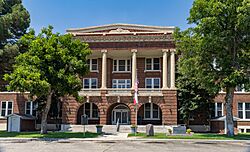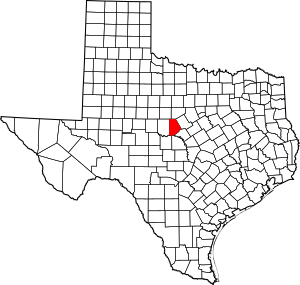Brown County, Texas facts for kids
Quick facts for kids
Brown County
|
|
|---|---|

The Brown County Courthouse in Brownwood
|
|

Location within the U.S. state of Texas
|
|
 Texas's location within the U.S. |
|
| Country | |
| State | |
| Founded | 1858 |
| Named for | Henry Stevenson Brown |
| Seat | Brownwood |
| Largest city | Brownwood |
| Area | |
| • Total | 957 sq mi (2,480 km2) |
| • Land | 944 sq mi (2,440 km2) |
| • Water | 13 sq mi (30 km2) 1.3% |
| Population
(2020)
|
|
| • Total | 38,095 |
| • Density | 40/sq mi (20/km2) |
| Time zone | UTC−6 (Central) |
| • Summer (DST) | UTC−5 (CDT) |
| Congressional district | 11th |
Brown County is a county in west-central Texas. As of the 2020 census, the population was 38,095. Its county seat is Brownwood. The county was founded in 1856 and organized in 1858. It is named for Henry Stevenson Brown, a commander at the Battle of Velasco, an early conflict between Texians and Mexicans. The Brownwood, TX Micropolitan Statistical Area includes all of Brown County.
Contents
History
- Among first inhabitants were the Penteka.
- 1721 The Marqués de San Miguel de Aguayo expedition is said to have passed through the county.
- 1838 Land surveys are made of the area.
- 1856 Mississippi transplant Welcome W. Chandler becomes the first settler, arriving with his family, John H. Fowler, and seven slaves. They built a log cabin on Pecan Bayou. The county is formed from Comanche and Travis. It is named after pioneer from Kentucky, Henry Stevenson Brown.
- 1858 The county is organized. Brownwood is the county seat.
- 1874 John Wesley Hardin and gang celebrate his 21st birthday in Brown and Comanche Counties. Deputy Charles Webb draws his gun, provoking a gunfight that ends Webb’s life. A lynch mob is formed, but Hardin and his family are put into protective custody. The mob breaks into the jail and hangs his brother Joe and two cousins. Hardin flees.
- 1875 The Fort Worth-Brownwood stage is robbed five times in two months.
- 1879 Oil is discovered on the H. M. Barnes farm near Grosvenor.
- 1886 Texas Rangers kill two fence cutters in the ongoing battle between farmers and ranchers over fencing open range.
- 1890 Cotton becomes the county’s important crop.Pulitzer Prize author Katherine Ann Porter is born at Indian Creek.
- 1889 Howard Payne College and Daniel Baker College are established in Brownwood.
- 1892 The Fort Worth and Rio Grande Railway is built to the county.
- 1895 The Gulf, Colorado and Santa Fe Railway built into Brownwood.
- 1903 The Gulf, Colorado and Santa Fe line extends the line to Menard. The county votes itself a dry county. Alcohol would not become legal again until the 1950s.
- 1909 The boll weevil moves into the county, destroying the cotton economy.
- 1917 First commercial production of oil comes from the efforts of Jack Pippen at Brownwood.
- 1919 The first large field begins producing from a depth of 1,100 feet (340 m) in 1919 near Cross Cut.
- 1926 An oil boom follows the success of the White well on Jim Ned Creek; some 600 wells are drilled in several fields in the county during this time.
- 1938 Lake Brownwood State Park opens to the public.
- 1940 Work begins on Camp Bowie .
- 1943 The first German prisoners of war arrive; many are members of Erwin Rommel's Afrika Corps.
- 1953 Howard Payne College and Daniel Baker College combine under the name Howard Payne College.
- 1991 More than 50,561,000 barrels (8,038,600 m3) of oil had been taken from Brown County lands since 1917.
Geography
According to the U.S. Census Bureau, the county has a total area of 957 square miles (2,480 km2), of which 944 square miles (2,440 km2) is land and 13 square miles (34 km2) (1.3%) is water.
Major highways
 U.S. Highway 67
U.S. Highway 67 U.S. Highway 84
U.S. Highway 84 U.S. Highway 183
U.S. Highway 183 U.S. Highway 377
U.S. Highway 377 State Highway 279
State Highway 279 Farm to Market Road 45
Farm to Market Road 45
Adjacent counties
- Eastland County (north)
- Comanche County (northeast)
- Mills County (southeast)
- San Saba County (south)
- McCulloch County (southwest)
- Coleman County (west)
- Callahan County (northwest)
Demographics
| Historical population | |||
|---|---|---|---|
| Census | Pop. | %± | |
| 1860 | 244 | — | |
| 1870 | 544 | 123.0% | |
| 1880 | 8,414 | 1,446.7% | |
| 1890 | 11,421 | 35.7% | |
| 1900 | 16,019 | 40.3% | |
| 1910 | 22,935 | 43.2% | |
| 1920 | 21,682 | −5.5% | |
| 1930 | 26,382 | 21.7% | |
| 1940 | 25,924 | −1.7% | |
| 1950 | 28,607 | 10.3% | |
| 1960 | 24,728 | −13.6% | |
| 1970 | 25,877 | 4.6% | |
| 1980 | 33,057 | 27.7% | |
| 1990 | 34,371 | 4.0% | |
| 2000 | 37,674 | 9.6% | |
| 2010 | 38,106 | 1.1% | |
| 2020 | 38,095 | 0.0% | |
| U.S. Decennial Census 1850–2010 2010 2020 |
|||
| Race / Ethnicity (NH = Non-Hispanic) | Pop 2000 | Pop 2010 | Pop 2020 | % 2000 | % 2010 | % 2020 |
|---|---|---|---|---|---|---|
| White alone (NH) | 29,772 | 28,478 | 26,672 | 79.03% | 74.73% | 70.01% |
| Black or African American alone (NH) | 1,473 | 1,303 | 1,353 | 3.91% | 3.42% | 3.55% |
| Native American or Alaska Native alone (NH) | 141 | 170 | 134 | 0.37% | 0.45% | 0.35% |
| Asian alone (NH) | 129 | 160 | 269 | 0.34% | 0.42% | 0.71% |
| Pacific Islander alone (NH) | 2 | 14 | 27 | 0.01% | 0.04% | 0.07% |
| Other Race alone (NH) | 13 | 36 | 96 | 0.03% | 0.09% | 0.25% |
| Mixed Race or Multiracial (NH) | 351 | 492 | 1,333 | 0.93% | 1.29% | 3.50% |
| Hispanic or Latino (any race) | 5,793 | 7,453 | 8,211 | 15.38% | 15.95% | 21.55% |
| Total | 37,674 | 38,106 | 38,095 | 100.00% | 100.00% | 100.00% |
As of the census of 2000, 37,674 people, 14,306 households, and 10,014 families resided in the county. The population density was 40 people per square mile (15 people/km2). The 17,889 housing units averaged 19 units per square mile (7.3/km2). The racial makeup of the county was 87.35% White, 4.01% Black or African American, 0.53% Native American, 0.37% Asian, 6.08% from other races, and 1.66% from two or more races. About 15.38% of the population was Hispanic or Latino of any race.
Of the 14,306 households in the county, 31.40% had children under the age of 18 living with them, 55.90% were married couples living together, 10.90% had a female householder with no husband present, and 30.00% were not families. About 26.50% of all households were made up of individuals, and 12.40% had someone living alone who was 65 years of age or older. The average household size was 2.48 and the average family size was 2.98.
In the county, the population was distributed as 25.80% under the age of 18, 10.10% from 18 to 24, 24.70% from 25 to 44, 22.90% from 45 to 64, and 16.40% who were 65 years of age or older. The median age was 37 years. For every 100, there were 97.40 males. For every 100 females age 18 and over, there were 93.10 males.
The median income for a household in the county was $30,974, and for a family was $37,725. Males had a median income of $30,169 versus $19,647 for females. The per capita income for the county was $15,624. About 14.00% of families and 17.20% of the population were below the poverty line, including 22.70% of those under age 18 and 12.10% of those age 65 or over.
Media
The Brownwood Bulletin is the local daily newspaper, an American Consolidated Media company that also serves media online through its website. Brown County is part of the Abilene/Sweetwater/Brownwood television media market. Area television stations include KRBC-TV, KTXS-TV, KXVA, KTAB-TV, and KIDU-LD.
Communities
Cities
Town
Census-designated places
Unincorporated communities
Education
School districts include:
- Bangs Independent School District
- Blanket Independent School District
- Brookesmith Independent School District
- Brownwood Independent School District
- Cross Plains Independent School District
- Early Independent School District
- May Independent School District
- Mullin Independent School District
- Rising Star Independent School District
- Zephyr Independent School District
The community college for the county is Ranger Junior College District, according to the Texas Education Code.
See also
 In Spanish: Condado de Brown (Texas) para niños
In Spanish: Condado de Brown (Texas) para niños

